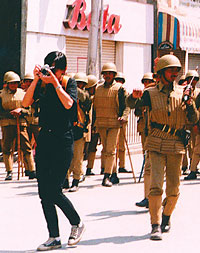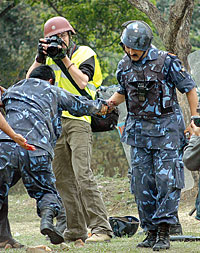|
|
| 1990 |
This happened to be the same day when the public in Patan staged a demonstration that ended in a clash with police in which two local Newar youths were killed in police firing. With this incident as a turning point, the movement started to take the real shape of Jana Andolan (People's Movement).
Immediately after the incident, people in Patan started to prevent the police from entering their city by blocking the entry points and they declared their town a 'Free Zone'. The agitation soon spread to Kirtipur and then to Kathmandu. Kirtipures also came out on the street s on 2 April and began to make their place police-free.
The climax came on 6 April. After hearing the king's proclamation to dismiss prime minister Marichman Singh Shrestha and to appoint loyalist Lokendra Bahadur Chand, angry citizens spontaneously came out to take part in demonstrations. I clearly remember how the people openly chanted anti-Panchayat slogans and how the police were shaking hands with demonstrators.
Most of the people in this historical demonstration were not party activists but members of the general public who had never taken part in a political rally before. The main reason that brought the people, especially professionals and the local Newars, to the streets was state suppression of the movement.
|
|
| 2006 |
The 2006 movement is spreading more rapidly across the country than the 1990 one. Partly it is because of the atrocities committed by the police and the army backed by the king's absolute power. The difference with 1990 is the presence of media-especially photojournalism, tv and FM-in witnessing and reporting in graphic detail the daily demonstrations. The slogans for Loktantra (democracy without a king) are spreading.
There is the possibility of even more strict suppression by the state through direct deployment of the Royal Nepali Army. But I don't see how that is going to stop this movement since it is rooted in the failure of all rulers, including the monarchy and the political parties.
The international community, including the US government, has been sharply critical of the king and his regime for their crackdowns on pro-democracy supporters. The party leaders now need to come out into the streets, not hide in their safe havens and make speeches from the pulpit of the Reporters' Club.
They have to be ready to stand in front of the guns and lathis to make their goal clear and assert their commitment before the people. Otherwise, party leaders have no right to claim any share of this Jana Andolan that will certainly bring a bigger change than 1990.
Most of those killed by the state in the Kathmandu Valley during the 1990 movement were Newars who belonged to the local community. Nearly all were non-political people. When I met their family members recently many expressed dissatisfaction with the political parties for their disregard of victims of the movement.
That is why local Newars, except inKirtipur, are still hesitating to join the present agitation. That must mean they still don't trust the political parties. Political leaders should not expect them to join the movement but should take leadership and responsibility for the movement.
Japanese journalist Kiyoko Ogura is the author of Kathmandu Spring: The People's Movement of 1990 (Himal Books 2001) and its original in Japanese.





